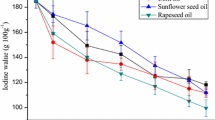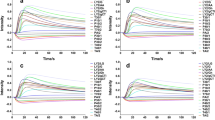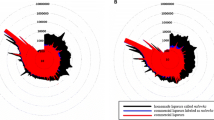Abstract
Food adulteration is a global concern that affects almost all the food industry. The market for clove essential oil (CEO) has also been affected by corrupt practices. As an alternative to monitoring the quality of this product, an electronic nose (e-nose) based on an array of polymeric nanocomposite gas sensors modified with different sensitive layers was applied to detect vaseline (petroleum jelly), the most common adulterant found in the CEO. Different proportions of vaseline (ranging from 3 to 100% (v/v)) were mixed with CEO samples, and the fingerprints of volatile compounds were obtained using the e-nose and Fourier transform infrared-attenuated total reflectance (FTIR-ATR) spectroscopy. Collected data were analyzed using clustering analysis (CA), principal component analysis (PCA), linear discriminant analysis (LDA), and interactive document map (IDMAP) multivariate projection techniques. These were capable of discriminating between the different percentages of adulterants. The results of this study demonstrated that chemometric tools can be successfully used as e-nose and applied to detect mislabeling and adulteration of CEO, where PCA, LDA, and IDMAP showed accuracies of 99.85, 98.30, and 99.81%, respectively. The e-nose results were consistent with the findings from density and refractive index experiments. Thus, the results obtained demonstrate that the e-nose is a promising tool for analyzing CEO adulterations, proving its potential application in the food industry due to its rapid, economical, and high-performance tool.









Similar content being viewed by others
Data Availability
No new data were created.
References
Affonso RDS, Rennó MN, Slana GBCA, Franca TCC (2012) Chemical and biological aspects of the essential oil of indian cloves. Rev Virtual Química 4:146–161. https://doi.org/10.5935/1984-6835.20120012
Aghili NS, Rasekh M, Karami H et al (2022) Detection of fraud in sesame oil with the help of artificial intelligence combined with chemometrics methods and chemical compounds characterization by gas chromatography–mass spectrometry. LWT 167:113863. https://doi.org/10.1016/j.lwt.2022.113863
Amelia B, Saepudin E, Cahyana AH et al (2017) GC-MS analysis of clove (Syzygium aromaticum) bud essential oil from Java and Manado. In: AIP conference proceedings 1862:030082. https://doi.org/10.1063/1.4991186
Ballen SC, Graboski AM, Manzoli A et al (2020) Monitoring aroma release in gummy candies during the storage using electronic nose. Food Anal Methods 13:3–12. https://doi.org/10.1007/s12161-019-01496-6
De Géa NM, Poppi RJ (2018) Monitoring of adulteration and purity in coconut oil using raman spectroscopy and multivariate curve resolution. Food Anal Methods 11:1897–1905. https://doi.org/10.1007/s12161-017-1093-x
Do TKT, Hadji-Minaglou F, Antoniotti S, Fernandez X (2015) Authenticity of essential oils. TrAC Trends Anal Chem 66:146–157. https://doi.org/10.1016/j.trac.2014.10.007
Feltes G, Steffens J, Paroul N, Steffens C (2023) Chapter 13 - Organic electronic nose applied to food traceability, adulteration, and authenticity. In: Gupta RK, Nguyen TA, Bilal M, Ahmadi MBT-N-BE (eds) Woodhead publishing series in electronic and optical materials. Woodhead Publishing, pp 299–328
Galvagni E, Fritzen AA, Graboski AM et al (2020) Detection of volatiles in dark chocolate flavored with orange essential oil by electronic nose. Food Anal Methods 13:1421–1432. https://doi.org/10.1007/s12161-020-01763-x
Graboski AM, Galvagni E, Manzoli A et al (2018b) Lab-made electronic-nose with polyaniline sensor array used in classification of different aromas in gummy candies. Food Res Int 113:309–315. https://doi.org/10.1016/j.foodres.2018.07.011
Graboski AM, Zakrzevski CA, Shimizu FM et al (2020) Electronic nose based on carbon nanocomposite sensors for clove essential oil detection. ACS Sensors 5:1814–1821. https://doi.org/10.1021/acssensors.0c00636
Graboski AM, Ballen SC, Manzoli A et al (2018a) Array of different polyaniline-based sensors for detection of volatile compounds in gummy candy. Food Anal Methods 11. https://doi.org/10.1007/s12161-017-0977-0
Heredia-Guerrero JA, Ceseracciu L, Guzman-Puyol S et al (2018) Antimicrobial, antioxidant, and waterproof RTV silicone-ethyl cellulose composites containing clove essential oil. Carbohydr Polym 192:150–158. https://doi.org/10.1016/J.CARBPOL.2018.03.050
IAL (2008) Instituto Adolfo Lutz. Métodos físico-químicos para análise de alimentos. São Paulo
Karami H, Rasekh M, Mirzaee‐Ghaleh E (2020) Application of the E‐nose machine system to detect adulterations in mixed edible oils using chemometrics methods. J Food Process Preserv 44. https://doi.org/10.1111/jfpp.14696
Kheawfu K, Pikulkaew S, Rades T et al (2018) Development and characterization of clove oil nanoemulsions and self-microemulsifying drug delivery systems. J Drug Deliv Sci Technol 46:330–338. https://doi.org/10.1016/j.jddst.2018.05.028
Niu B, Zhang H, Zhou G et al (2021) Safety risk assessment and early warning of chemical contamination in vegetable oil. Food Control 125:107970. https://doi.org/10.1016/j.foodcont.2021.107970
Ospina JD, Tovar CDG, Flores JCM, Orozco MSS (2016) Relationship between refractive index and thymol concentration in essential oils of Lippia origanoides Kunth. Anim Sci, Ex Agro-Ciencia 32(127):133
Paulovich FV, Moraes ML, Maki RM et al (2011) Information visualization techniques for sensing and biosensing. Analyst 136:1344. https://doi.org/10.1039/c0an00822b
Peris M, Escuder-Gilabert L (2016) Electronic noses and tongues to assess food authenticity and adulteration. Trends Food Sci Technol 58:40–54. https://doi.org/10.1016/j.tifs.2016.10.014
Pochivalov KV, Basko AV, Shilov AN et al (2018) Thermal and optical studies on the compositions of low-density polyethylene with highly refined mineral oil. Thermochim Acta 669:45–51. https://doi.org/10.1016/J.TCA.2018.09.008
Pulluri KK, Kumar VN (2022) Qualitative and quantitative detection of food adulteration using a smart E-Nose. Sensors 22:7789. https://doi.org/10.3390/s22207789
Rahman SMA, Van TC, Hossain FM et al (2019) Fuel properties and emission characteristics of essential oil blends in a compression ignition engine. Fuel 238:440–453. https://doi.org/10.1016/j.fuel.2018.10.136
Rañola RAG, Santiago KS, Sevilla FB (2016) Use of array of conducting polymers for differentiation of coconut oil products. Talanta 146:75–82. https://doi.org/10.1016/j.talanta.2015.08.026
Rasekh M, Karami H, Wilson AD, Gancarz M (2021) Classification and identification of essential oils from herbs and fruits based on a MOS electronic-nose technology. Chemosensors 9:142. https://doi.org/10.3390/chemosensors9060142
Rodrigues N, Ferreiro N, Veloso ACA et al (2022) An electronic nose as a non-destructive analytical tool to identify the geographical origin of portuguese olive oils from two adjacent regions. Sensors 22:9651. https://doi.org/10.3390/s22249651
Rousseeuw PJ (1987) Silhouettes: a graphical aid to the interpretation and validation of cluster analysis. J Comput Appl Math 20:53–65. https://doi.org/10.1016/0377-0427(87)90125-7
Roy M, Yadav BK (2022) Electronic nose for detection of food adulteration: a review. J Food Sci Technol 59:846–858. https://doi.org/10.1007/s13197-021-05057-w
Santos A, Paduan RH, Gazin ZC et al (2009) Determinação do rendimento e atividade antimicrobiana do óleo essencial de Cymbopogon citratus (DC.) Stapf em função de sazonalidade e consorciamento. Rev Bras Farmacogn 19:436–441. https://doi.org/10.1590/S0102-695X2009000300017
Schimidt E, Wanner J (2015) Adulteration of essential oils. In: Baser KHC, Buchbauer G (eds) Handbook of essential oils: science, technology, and applications, Second edi. CRC Press/Taylor & Francis, Boca Raton, pp 707–746
Speight JG (2002) Mineral oil (White oil). In: Handbook of petroleum product analysis. Wiley-Interscience, Canadá, p 247
Steffens C, Corazza ML, Franceschi E et al (2012) Development of gas sensors coatings by polyaniline using pressurized fluid. Sensors Actuators, B Chem 171–172:627–633. https://doi.org/10.1016/j.snb.2012.05.044
Tan J, Xu J (2020) Applications of electronic nose (e-nose) and electronic tongue (e-tongue) in food quality-related properties determination: a review. Artif Intell Agric 4:104–115. https://doi.org/10.1016/j.aiia.2020.06.003
Taraj K, Aandoni A, Fatos Y et al (2020) Spectroscopic investigation of Syzygium aromaticum L. oil by water distillation extraction. J Int Environ Appl Sci 15:122–126
Tarhan İ, Bakır MR, Kalkan O et al (2022) Rapid determination of adulteration of clove essential oil with benzyl alcohol and ethyl acetate: towards quality control analysis by FTIR with chemometrics. Vib Spectrosc 118:103339. https://doi.org/10.1016/j.vibspec.2022.103339
Tarhan İ, Çelikten Ş, Kestek HM et al (2023) Development of a new and rapid FTIR method using chemometric modeling techniques for the determination of lavandin adulteration in lavender essential oil. Vib Spectrosc 127:103559. https://doi.org/10.1016/j.vibspec.2023.103559
Taylan O, Cebi N, Sagdic O (2021) Rapid screening of mentha spicata essential oil and L-menthol in mentha piperita essential oil by ATR-FTIR spectroscopy coupled with multivariate analyses. Foods 10:202. https://doi.org/10.3390/foods10020202
Van Beek TA, Joulain D (2018) The essential oil of patchouli, Pogostemon cablin: a review. Flavour Fragr J 33:6–51. https://doi.org/10.1002/ffj.3418
Xu L, Yu X, Liu L, Zhang R (2016) A novel method for qualitative analysis of edible oil oxidation using an electronic nose. Food Chem 202:229–235. https://doi.org/10.1016/j.foodchem.2016.01.144
Xuan S, Zhang Y, Zhou Y et al (2012) Magnetic plasticine™: a versatile magnetorheological material. J Mater Chem 22:13395. https://doi.org/10.1039/c2jm32375c
Acknowledgements
The authors would like to thank the National Council for Scientific and Technological Development–Brazil (CNPq), Coordination for the Improvement of Higher Education Personnel–Brazil (CAPES)–Finance Code 001, Research Support Foundation of the State of Rio Grande of Sul–Brazil (FAPERGS), Financiadora de Estudos e Projetos (Finep), FAPESP (2012/15543-7, 2018/18953-8, and 2018/22214-6), and URI for their financial support.
Author information
Authors and Affiliations
Contributions
Adriana Marcia Graboski: conceptualization, formal analysis, and investigation; Giovana Feltes: formal analysis and investigation; Claudio Augusto Zakrzevski: formal analysis and investigation; Flavio Makoto Shimizu: methodology and validation; Juliana Steffens, Natália Paroul, and Clarice Steffens: resources, data curation, writing—original draft preparation, review, and editing.
Corresponding author
Ethics declarations
Ethics Approval
This article does not contain any studies with human or animal subjects.
Competing Interests
The authors declare no conflict of interest.
Additional information
Publisher's Note
Springer Nature remains neutral with regard to jurisdictional claims in published maps and institutional affiliations.
Rights and permissions
Springer Nature or its licensor (e.g. a society or other partner) holds exclusive rights to this article under a publishing agreement with the author(s) or other rightsholder(s); author self-archiving of the accepted manuscript version of this article is solely governed by the terms of such publishing agreement and applicable law.
About this article
Cite this article
Graboski, A.M., Feltes, G., Zakrzevski, C.A. et al. Adulteration of Clove Essential Oil: Detection Using an Electronic Nose with Polymeric Gas Sensors. Food Anal. Methods 17, 296–308 (2024). https://doi.org/10.1007/s12161-023-02564-8
Received:
Accepted:
Published:
Issue Date:
DOI: https://doi.org/10.1007/s12161-023-02564-8




